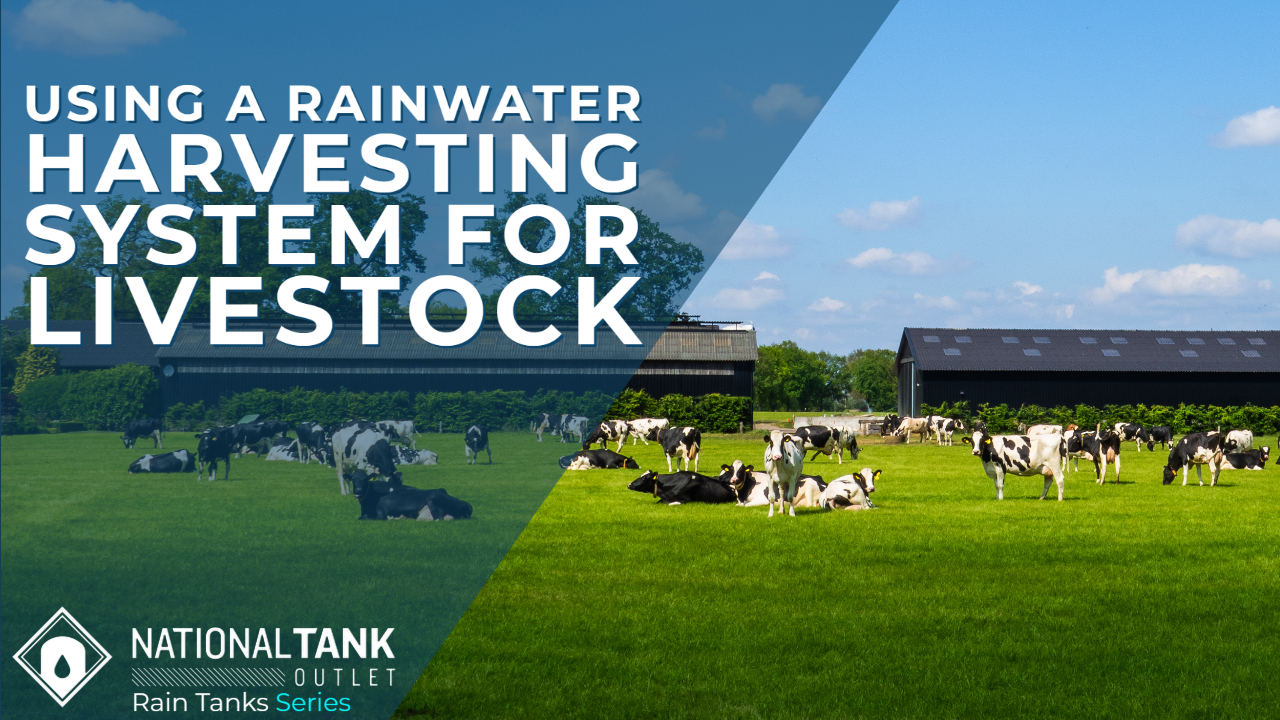
Rainwater harvesting is the practice of collecting the precipitation that regularly falls on a property for its use as an alternative or supplemental water source and supply in water-requiring activities. In this post, livestock is used to mean all manner of cattle, poultry, swine, sheep, goats, and horses.
Installing and using a rainwater harvesting system for livestock can reduce the reliance on municipal water supply and groundwater well sources, provide water during droughts, serve as an emergency backup supply, and can effectively lower operation costs. On livestock ranches and farms that use groundwater wells, rainwater harvesting can supplement the water supply to accommodate for shortages and slow aquifer recharge. On farms with drying wells or contaminated groundwater, rainwater harvesting can provide an alternative water supply and even be used in groundwater recharge.
With the proper setup, a rainwater system can:
- Supply drinking water for livestock
- Provide drinking water in remote locations without a water connection
- Refill and supplement surface water sources
- Be used in groundwater aquifer recharge
- Be used in feed preparation
- Provide water for cooling towers and equipment
- Be used for cleaning of livestock areas
- Be used in animal processing
- Irrigate pasture land to maintain growth during dry seasons
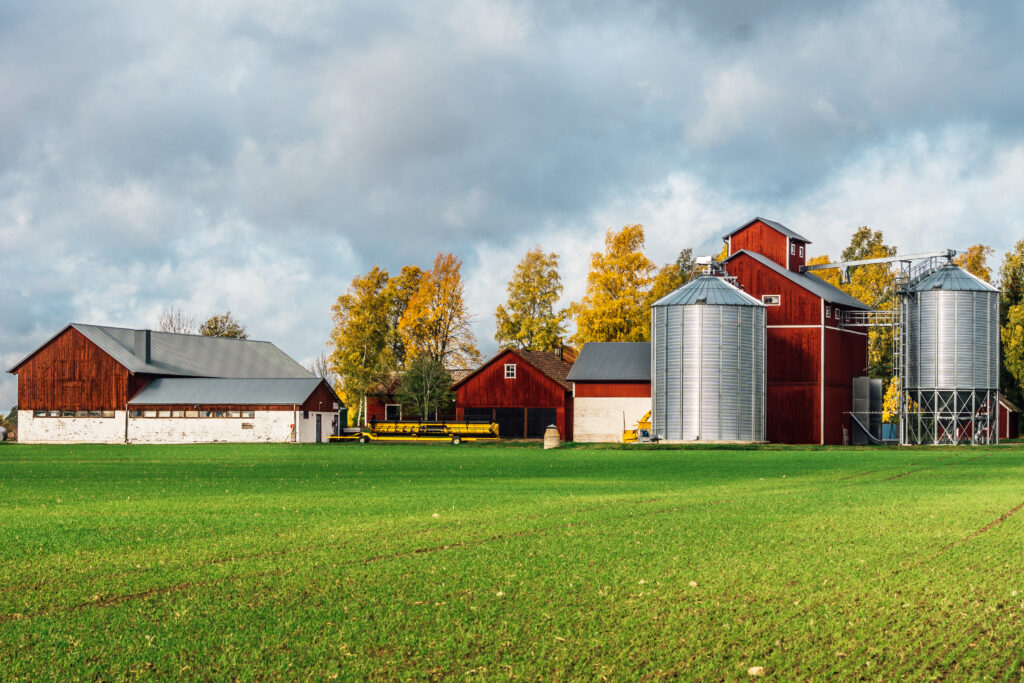
Defining Alternative vs Supplemental Rainwater Harvesting
What is meant by using rainwater harvesting as an alternative or supplemental water source? In practice:
1. Alternative means to use rainwater harvesting as an entirely different and separate option for water supply, removing reliance on another water source such as municipal, mains, or groundwater on the property.
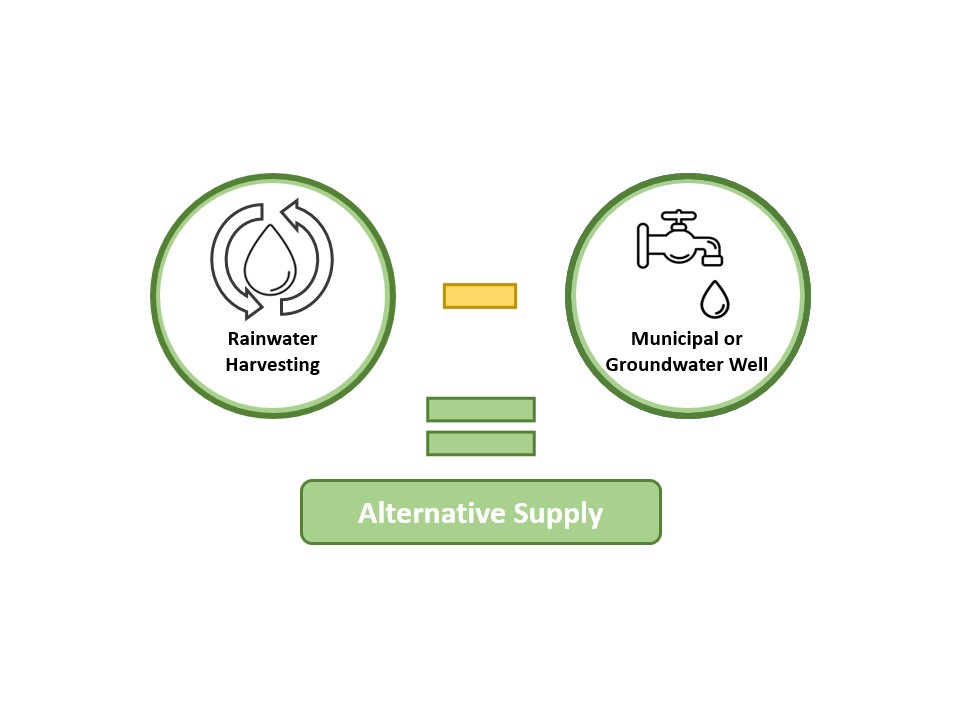
2. Supplemental means to use harvested rainwater along with the water from a main source to reduce the total amount of water required from that main source supply.
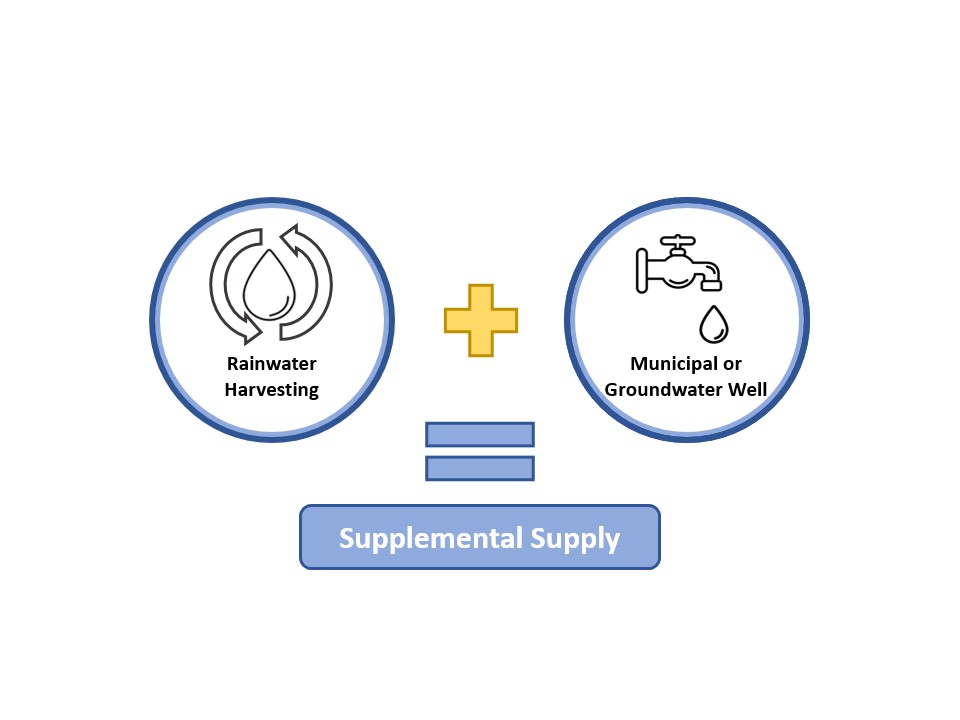
As an entirely alternative source, rainwater harvesting can supply and sustain all the water needed by an activity. As a supplemental source, rainwater harvesting will still require an outside source to fully meet water demands.
Whether a rainwater harvesting system can be an alternative source or will serve as a supplemental water supply for livestock will depend on:
- Average regional rainfall
- The volume of water needed based on livestock type and quantity
- Size of the rain catching area
- Total volume capacity of the storage tank or tanks
The Practice of Rainwater Harvesting is Ideal for Livestock Farms and Ranches
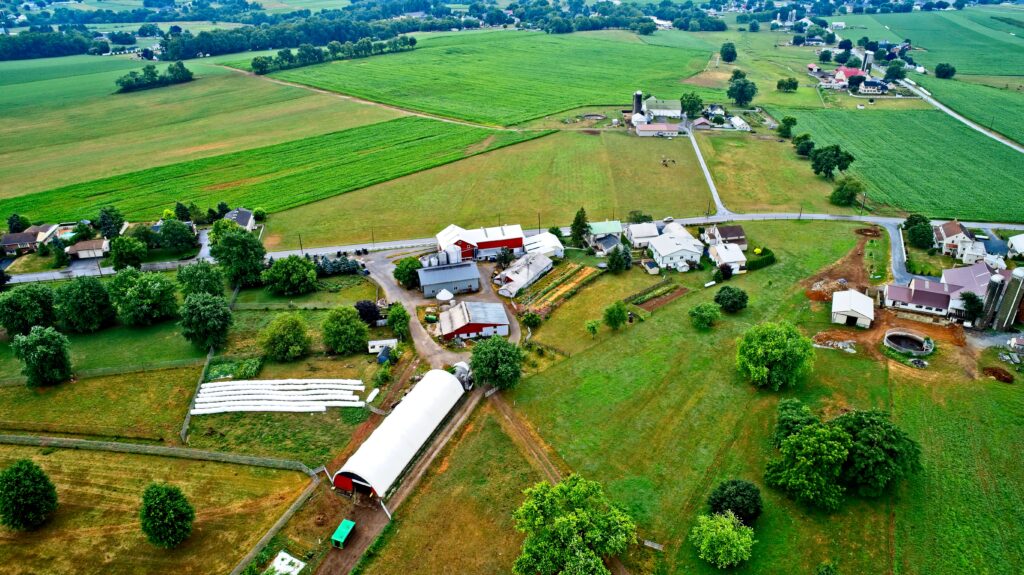
Many agriculture businesses and farms already have large sized structures on their property that are ideal for rainwater harvesting. Examples such as barns, sheds, livestock houses, warehouses, and equipment yards can have roofs with very large surface areas that are capable of collecting large volumes of rainfall. In addition to their large sizes, many farm buildings have metal, sheet type roofing that is better suited for rainwater harvesting compared to asphalt shingle roofing.
In example, having a building with a 10,000 square foot roof on a farm is not uncommon. Many farming operations have much larger buildings where a 40,000 square foot roof or bigger is common. Using the example of a 10,000 square foot roof, a single rainfall event with one (1) inch of rain could provide as much as 6,000 gallons of water. In an example with a 40,000 square foot roof, the yield could be as much as 25,000 gallons of water from a single one inch rainfall event.
The examples above demonstrate how much water could be provided from rainwater harvesting as an alternative or supplemental supply source for use in regular agriculture livestock operations. These examples are also based on only a single inch of rain. When using the average rainfall for the State of Texas at 28.9 inches, the 10,000 sq.ft. example could yield as much as 180,000 gallons, while the 40,000 sq.ft. example could yield as much as 720,000 gallons of water over the course of the year. This makes it easy to see that this is a lot of water – and free water – that could go a long way for ranch and livestock use.
In industrial livestock operations with many large buildings and many animals, such as the poultry farm in the image provided, the volume of rainfall that can be collected is potentially very high. Estimating each of the 38 poultry houses at 8,000 sq. ft. gives a total 304,000 square footage. If each building were setup to harvest rainwater, and the operation was in the rainy part of Kansas State with an average rainfall around 32 inches, then the total volume of water collected for livestock use could be as much as 6 million gallons.
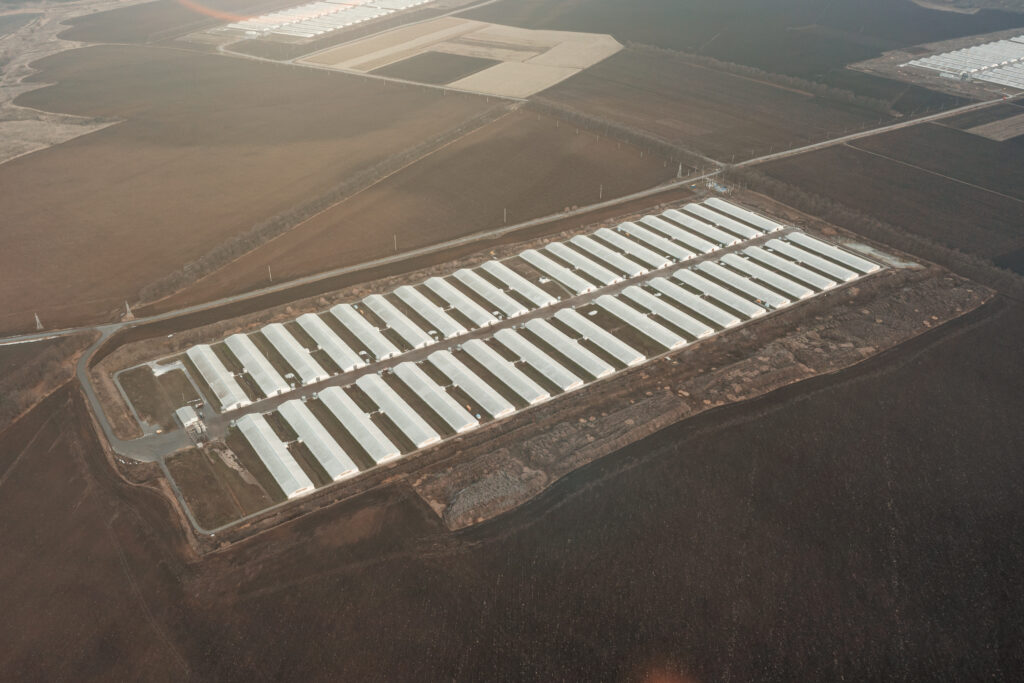
How Do I Calculate How Much Rainwater I Can Collect
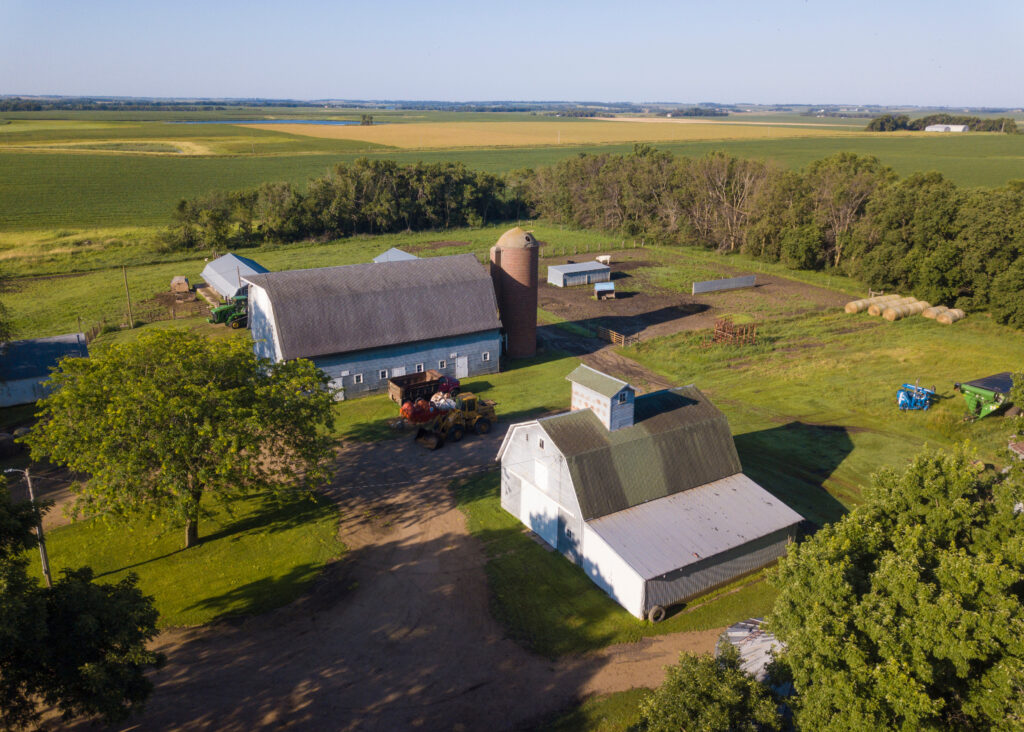
Now that we’ve provided some examples and scenarios showing how much water can be collected from rainwater harvesting, let’s look at how to calculate how much rainwater you can collect using your own rainfall information and measurements. The official equation for rainwater harvesting collection is:
Catchment Area (Square Feet) x Rainfall Amount (Inches) x 0.623 = Total Collected Rainwater Volume (Gallons)
In the above equation, if you (1) put in the size of the area you will use to collect rainwater from in square feet, then (2) multiply that by the amount of rain in inches and (3) multiply again by 0.623, you will get the total volume of rainwater you can collect. Easy: multiply square foot rain catching area, inches of rainfall, and 0.623 for rainwater collection volume.
Note: the 0.623 is a standard conversion factor for changing square feet and inches into gallons and will not change.
Using another example with a 3,200 square foot barn and 4 inches of rainfall during a month, the equation looks like this:
3,200 square feet x 4 inches x 0.623 = 7,974.4 gallons of collected rainwater volume
Now, to be more precise, a catchment efficiency percentage can be included in the equation to account for rainwater that is not collected by the rainwater system, such as due to spills, heavy rainfall overflow, etc. To include this, simply multiply your answer by whatever percent you estimate your rainwater system is working at. Using the last example, if you believe you will only catch 90% of the total rain that falls to your system, then multiply 7,974 by 90%, which means you will expect to collect around 7,177 gallons of rainwater.
Top States to Use Rainwater Harvesting for Livestock
If you live and operate a livestock operation in one of the following states: Texas, California, Iowa, Nebraska, Kansas, Idaho, North Carolina, Wisconsin, Missouri, Oklahoma, or Minnesota, then you are ideally positioned to both use and benefit from rainwater harvesting. According to the United States Geological Survey (USGS), these are the top states with the highest total water withdrawals and water use for livestock. This means these states have the largest livestock operations that are dependent on a consistent, reliable, and clean water supply for their livelihood and animal rearing.
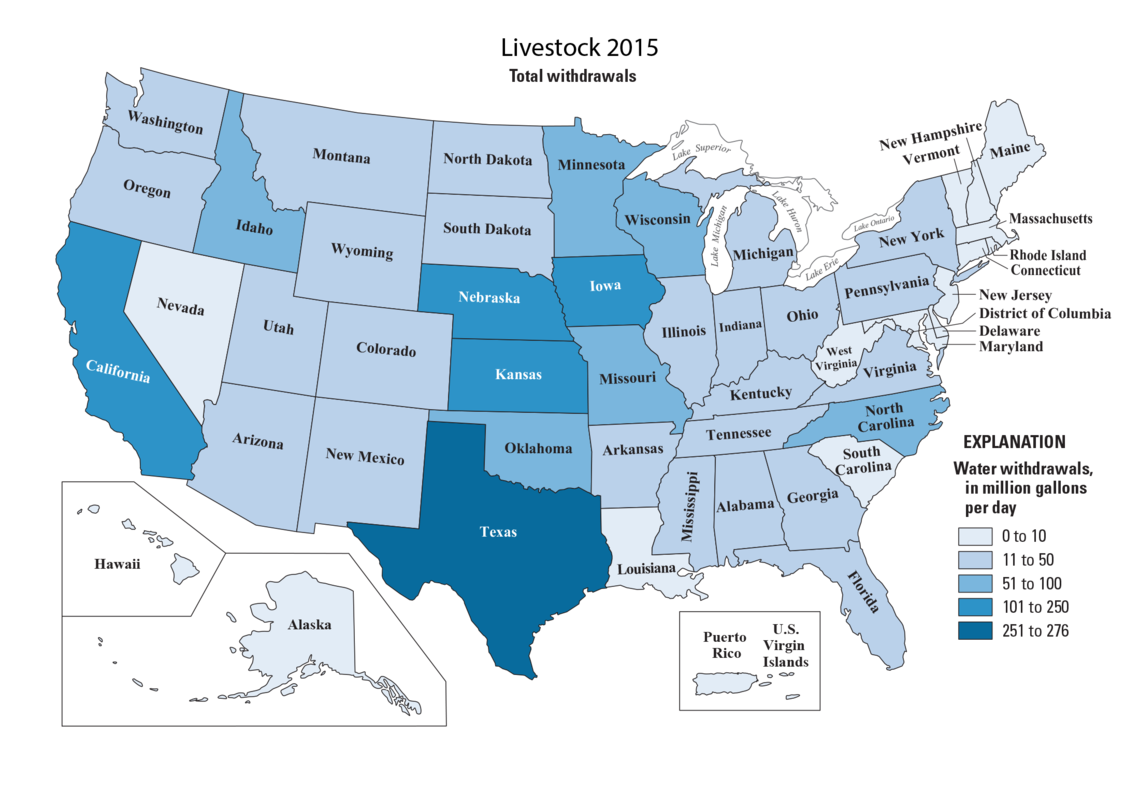
Also according the USGS, groundwater wells are the primary source for the water supplied to livestock in these states. The remaining is provided by surface water either from a municipality or from natural bodies of water located on the property.
Using rainwater harvesting as a supplemental water source or alternative supply can reduce or eliminate the dependence on these sources. This can lower utility bills, reduce concern with impacted water supplies and low aquifer levels, and will also provide the benefits rainwater harvesting has for the environment and in water conservation.
Average Yearly Rainfall for Top Livestock States
The following table provides the average rainfall volume in inches for each of these top states in using rainwater harvesting for livestock.
| U.S. State | Average Yearly Rainfall |
|---|---|
| Texas | 28.9 inches |
| California | 22.2 inches |
| Iowa | 34.0 inches |
| Nebraska | 23.6 inches |
| Kansas | 28.9 inches |
| Idaho | 18.9 inches |
| North Carolina | 49.8 inches |
| Wisconsin | 32.6 inches |
| Missouri | 42.2 inches |
| Oklahoma | 36.5 inches |
| Minnesota | 27.3 inches |
Note that these yearly rainfall values are averages for the entire state. Rainfall volumes are highly regional specific and can vary based on location even within the same state. The values are provided for reference and estimation in evaluating the ability of a rainwater harvesting system on your property.
We recommend checking with a reputable source such as weather.gov or a farmer’s almanac for your regional expected annual rainfall averages. The Gallery of State Maps provided by the PRISM Climate Group is also a good reference for state-by-state annual rainfall amounts.
Okay, I am Sold on Using Rainwater for Livestock — Now What Exactly Can I Use it For and How Do I Set Up a System?
With the right setup and equipment, water collected from rainwater harvesting can be used to supply the water needed for any livestock application. The main question then becomes not what can the rainwater be used for but how to collect enough rainwater volume to meet supply needs and how to clean the water so it is pure enough for the use.
With enough clean rainwater, the water can be used for any of the water requiring activities common in livestock raising and care. An example and non-exhaustive list of rainwater uses includes:
- For drinking water
- In feeding and feed preparation
- In pasture care and irrigation, especially during dry seasons to keep pasture grass growing
- As a reservoir, backup or emergency supply to provide water during shortages, droughts, or disasters that can affect the main water source supply
- Provide drinking water in remote locations without a water connection
- Provide water for cooling towers and equipment
- Used for cleaning of living areas, pens, houses and livestock
- In final animal processing
What Makes Up a Rainwater Harvesting System
Every successful rainwater harvesting system requires the same basic components as a starting point to build from and add on to. Known as the 3 C’s of Rainwater Harvesting, each basic system requires a catchment area, a conveyance system, and a collection container.
A catchment area is any surface that can be used for rainwater to fall on and be collected from. Catchment areas are most often the roof of a building or structure. It is at the catchment area that most rainwater becomes dirty with debris, animal droppings, remains, dust, pollen, airborne chemicals, and the like. Using a smooth, metal roof for a catchment area improves how easily the surface can be cleaned by rainfall, which over time helps to keep the overall system cleaner.
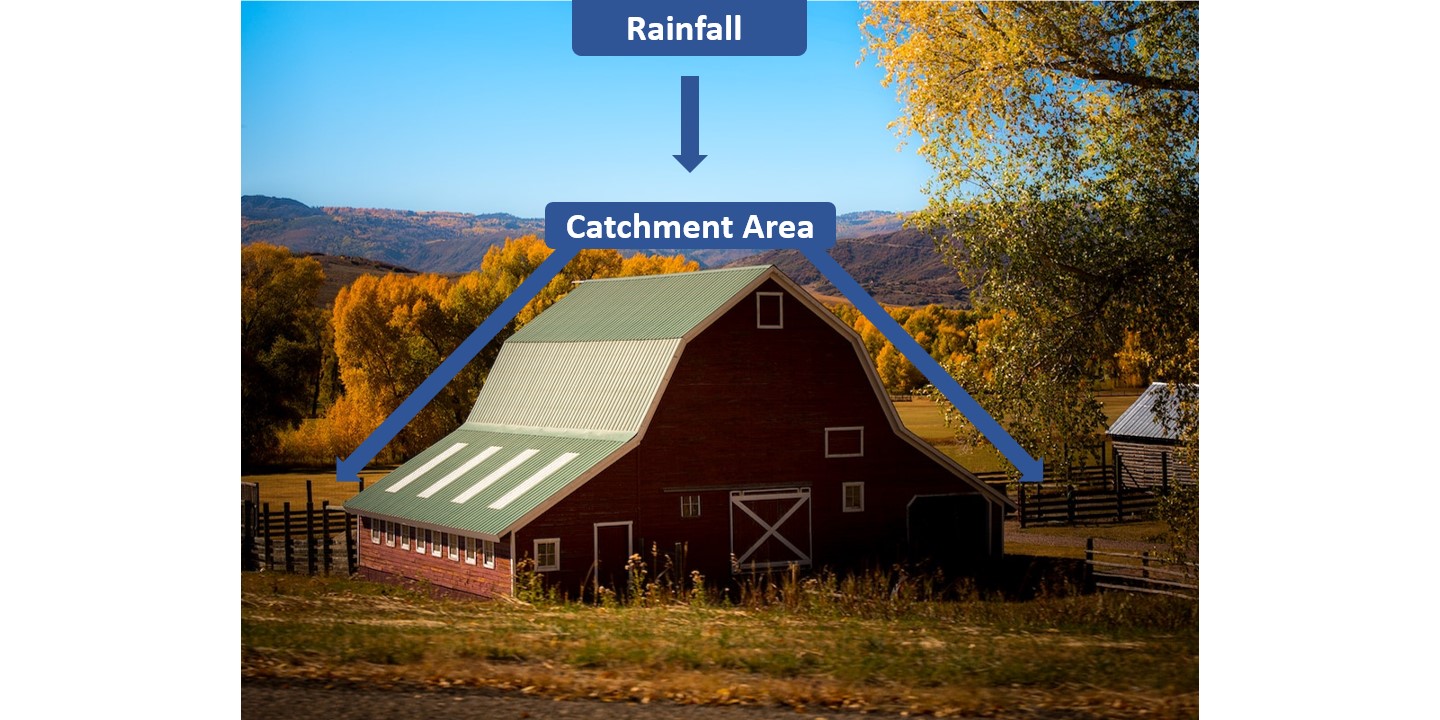
A conveyance system is the series of gutters, downspouts, and/or piping used to direct rainwater from the catchment area to the collection container. It is along the conveyance system that most debris can be cleaned from the rainwater through the use of gutter screens, leaf eaters, and first flush diverters.

A collection container is any watertight vessel used to store harvested rainwater for its use when needed. Rainwater collection containers are most often polyethylene storage tanks, underground cisterns, and galvanized steel water tanks. Important rainwater harvesting components at the collection container include a tank screen, overflow, and bulkhead fitting that will serve for water withdrawal and making connections to plumbing, hoses, a water pump and other equipment such as filtration.
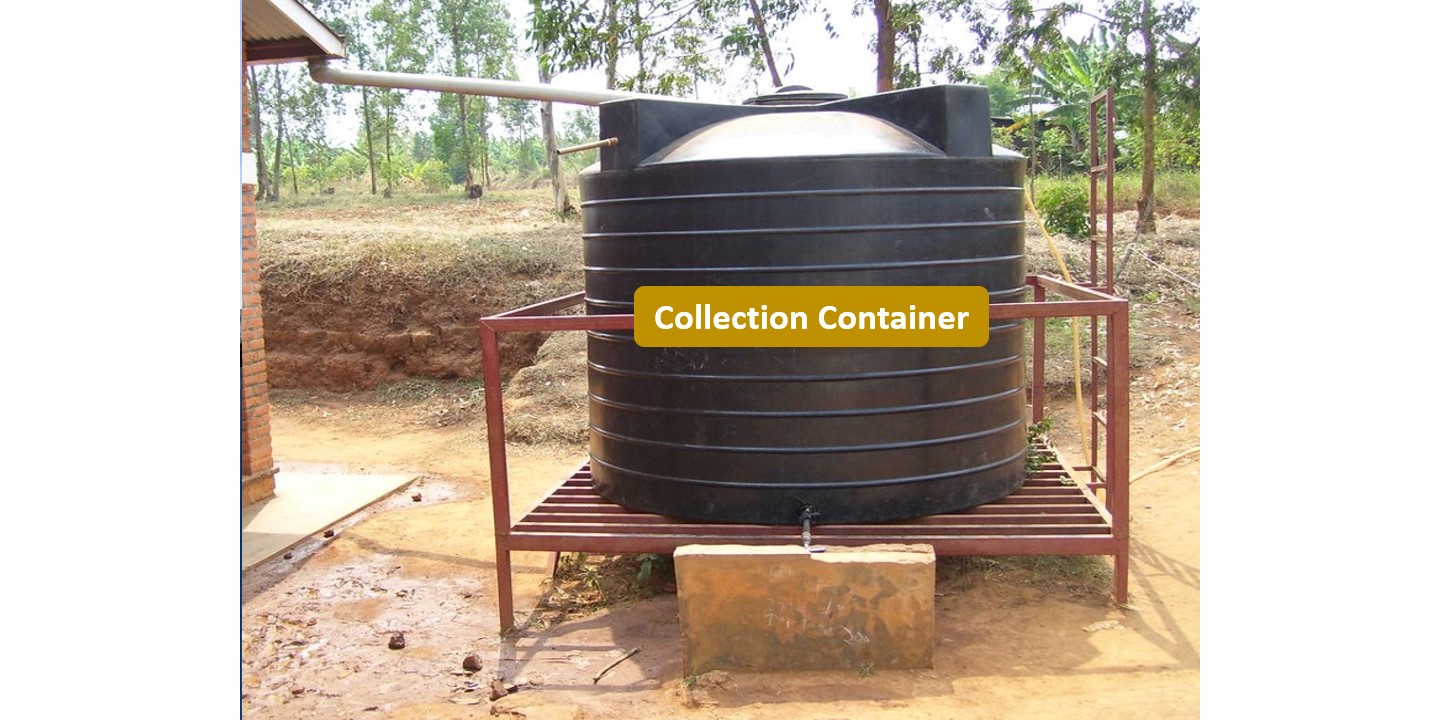
The components of a successful rainwater harvesting system include: the catchment area (roof), the conveyance system (gutters, downspouts, pipe), leaf eater(s), first flush diverter(s), tank screen with cover, collection container, overflow, bulkhead fitting, and the plumbing and equipment necessary to withdraw, use, and purify the harvested rainwater as needed. See our available rain harvesting accessories here.
How to Plan for a Rainwater System
Proper planning for a rainwater harvesting system will begin with an effective overview and consideration of:
- What the rainwater will be used for
- How much water volume will be needed
- The surface size rainwater will be collected from
- The amount of expected rainfall in the area
- The volume of rainwater that can be collected from the surface
- Proximity from the rain collection area to point of use
- How clean the water must be
- Additional equipment that will be needed
Once the above steps are known, a rainwater harvesting plan can be outlined and put in place to build from and set up a functional and effective system. Once you determine what the rainwater will be used for, (Step 1) you can estimate how much water volume you will need (Step 2); past water bills, use records, academic research or good approximation can help with this.
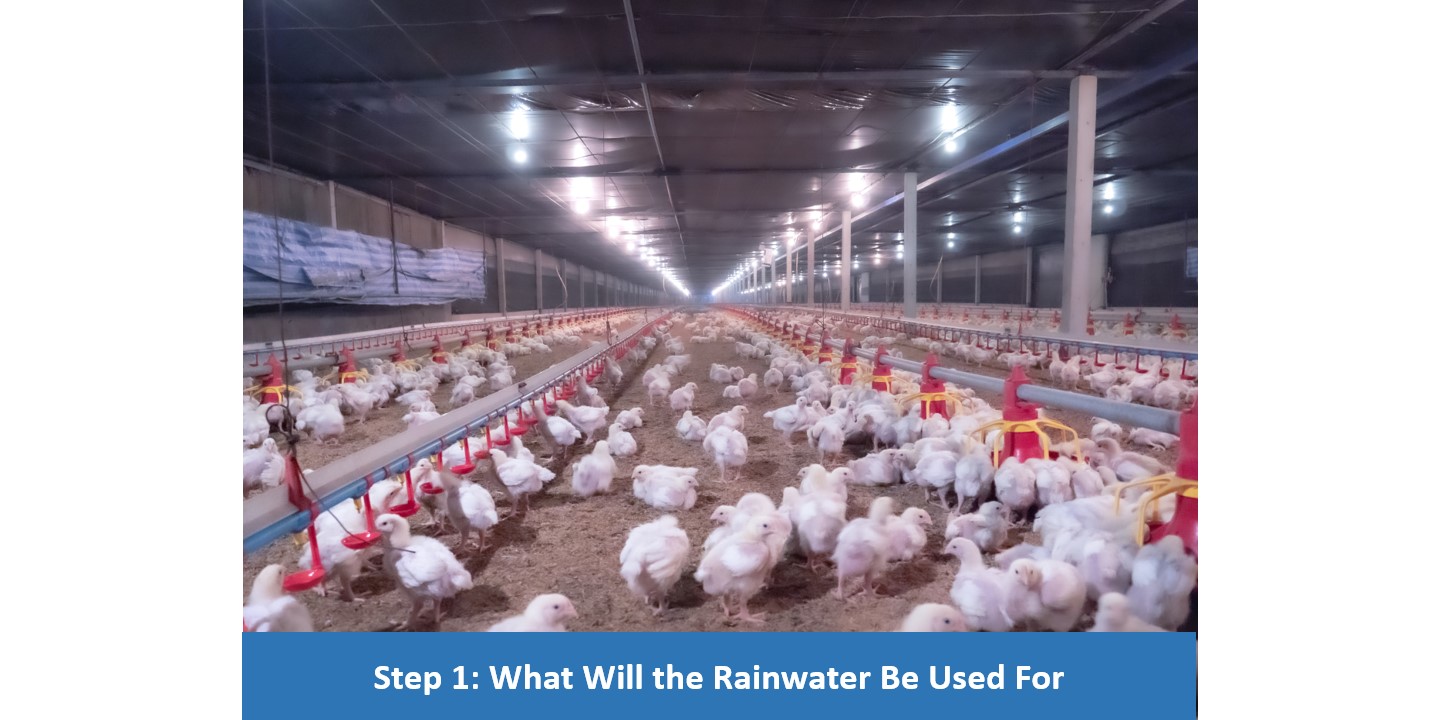
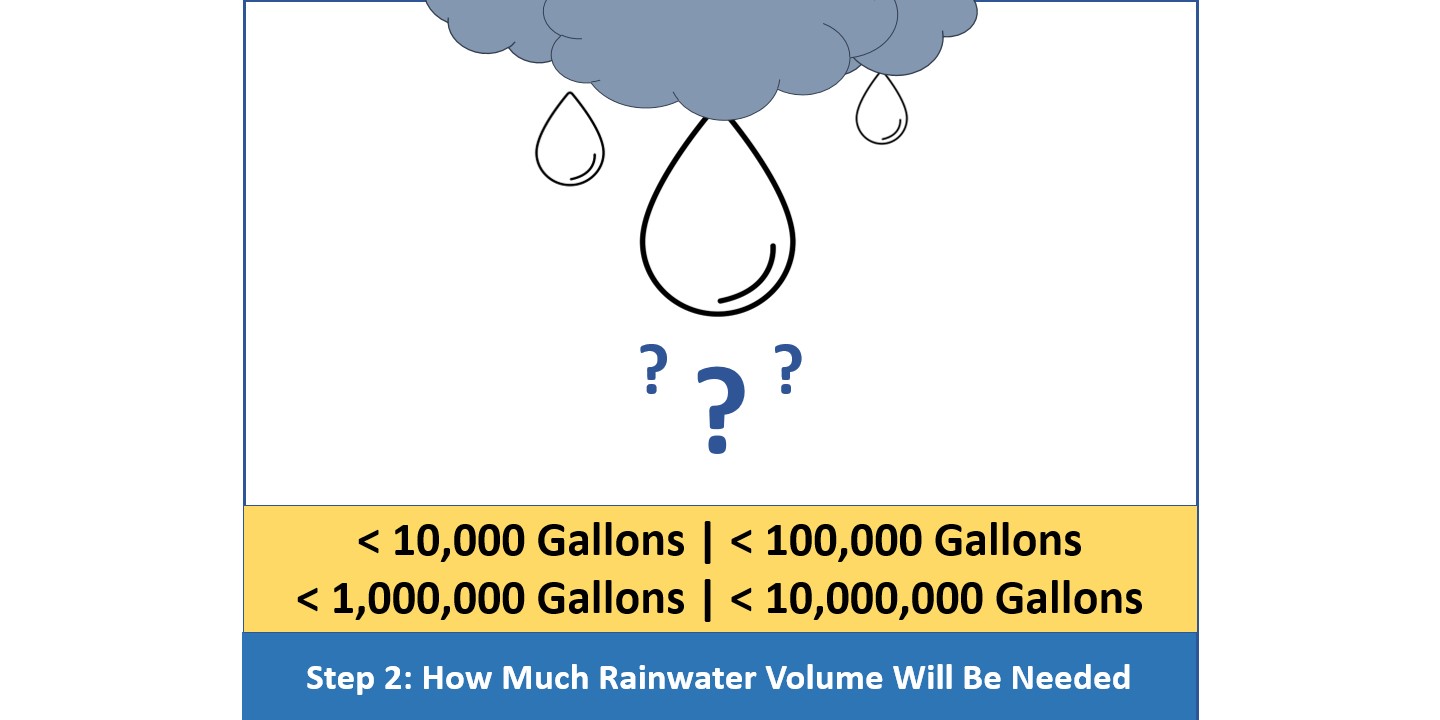
Knowing what the rainwater will be used for also directly relates to how clean the water must be (Step 7) and additional equipment that will be needed (Step 8).
Knowing the surface size rainwater will be collected from (Step 3) and …

The amount of expected rainfall in your area (Step 4) …
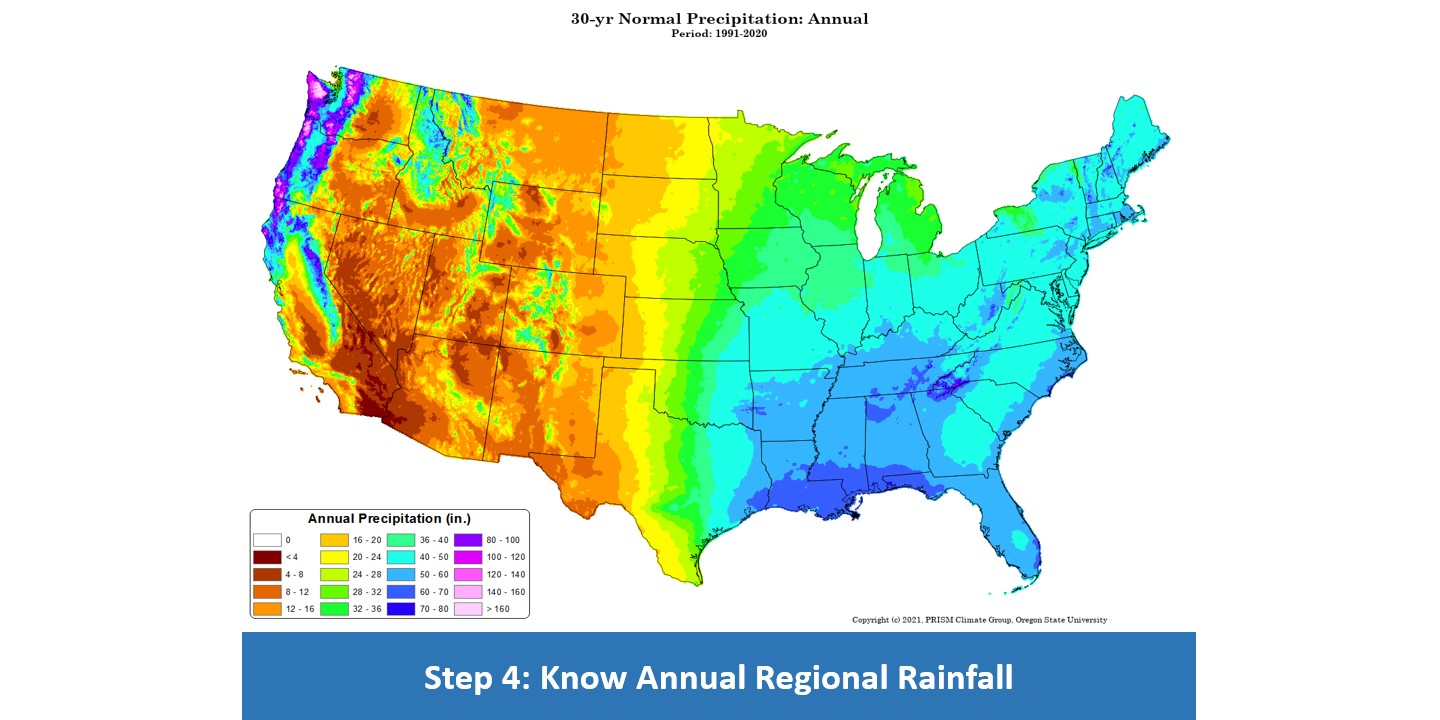
Will allow you to determine if you are able to harvest the volume of water you need (Step 5) as well as what size storage tank or tanks to use.
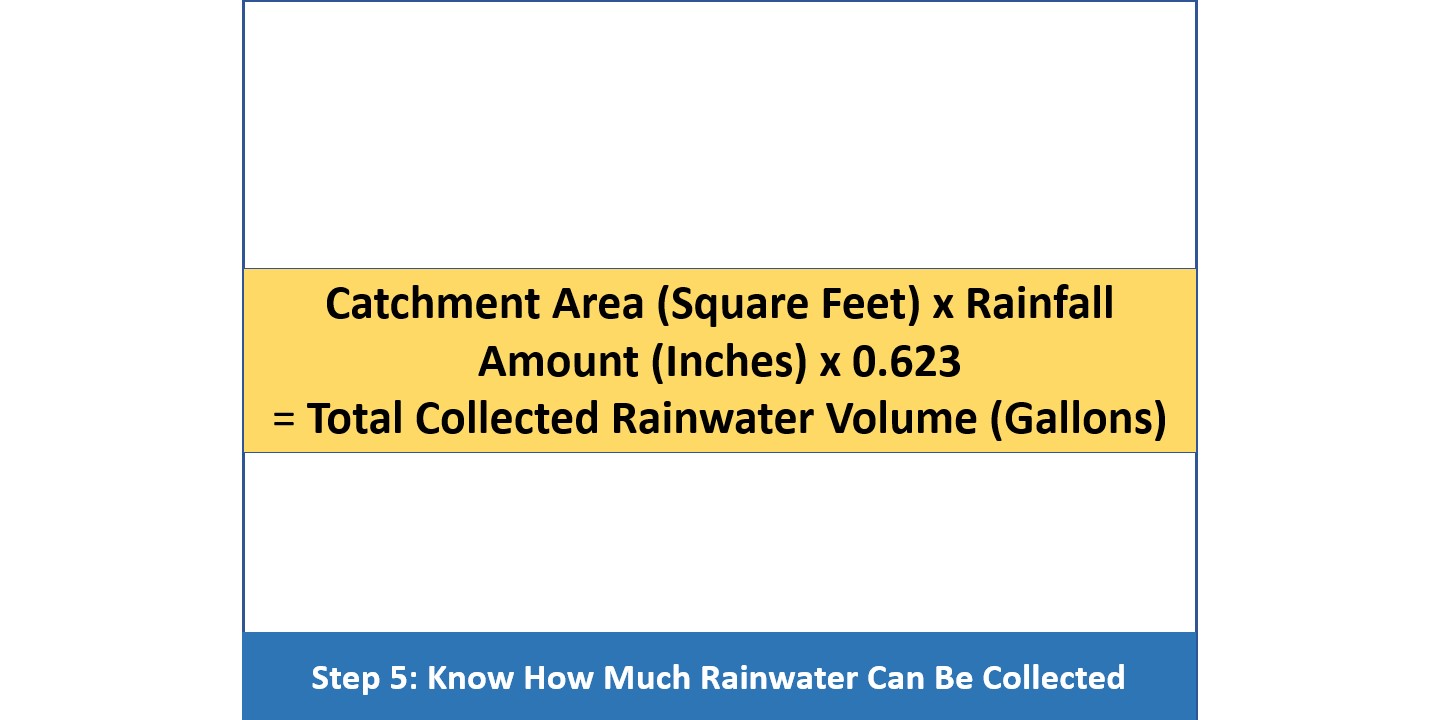
If you do not know the size of your intended catchment surface in square footage, you can easily measure it. When measuring, make sure to only measure the area that will be used to harvest rainwater or that will be connected to your system. To calculate square footage, simply measure and multiply the width by length in feet.
Being able to install a rainwater harvesting system near to the point of use (Step 6) will make for an easier to manage setup, reduce the amount of plumbing needed, and lower installation costs.
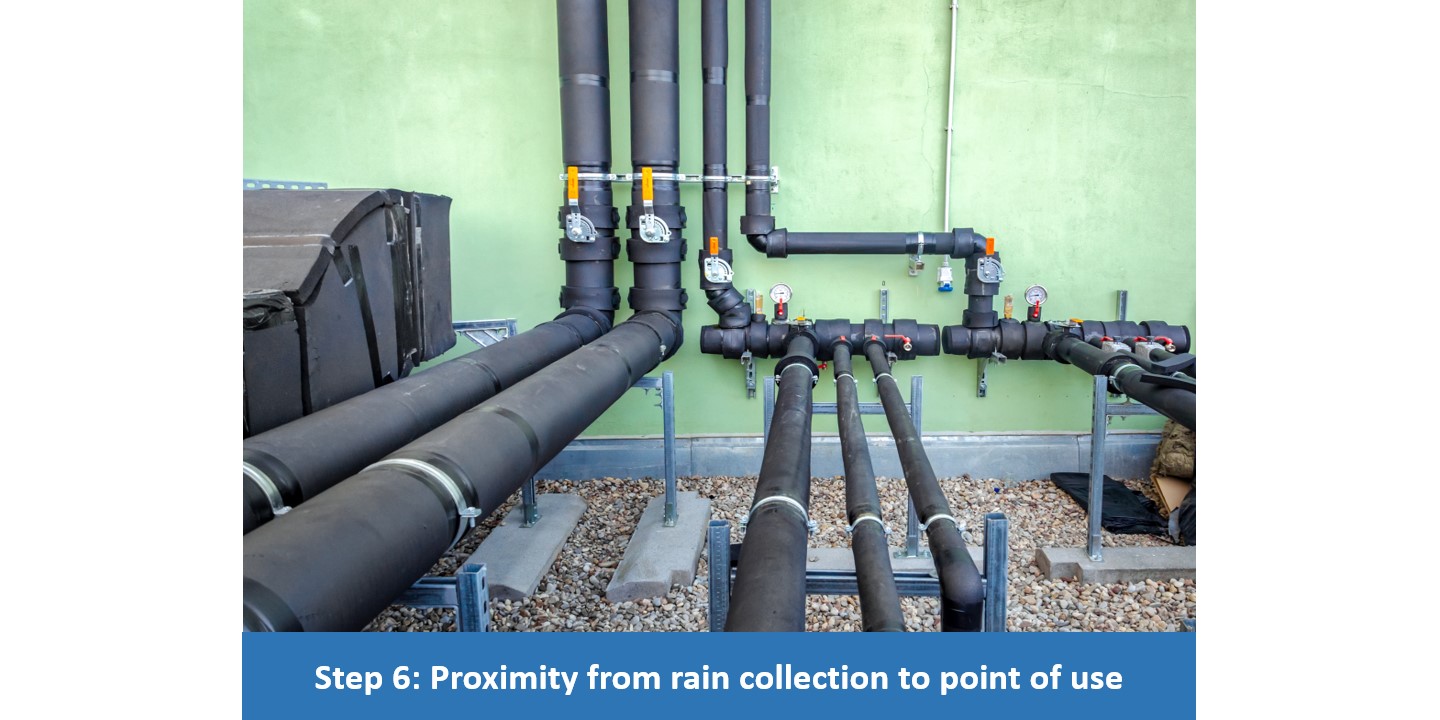
For the question of how clean the rainwater must be (Step 7), in general, if harvested rainwater will be used for any application where its main intent is to be consumed, (drinking water for livestock), where ingestion is likely, (cleaning) or a higher standard of purity is required for cleanliness or equipment operation (cooling, animal processing), then potable grade, drinking quality rainwater will be required.
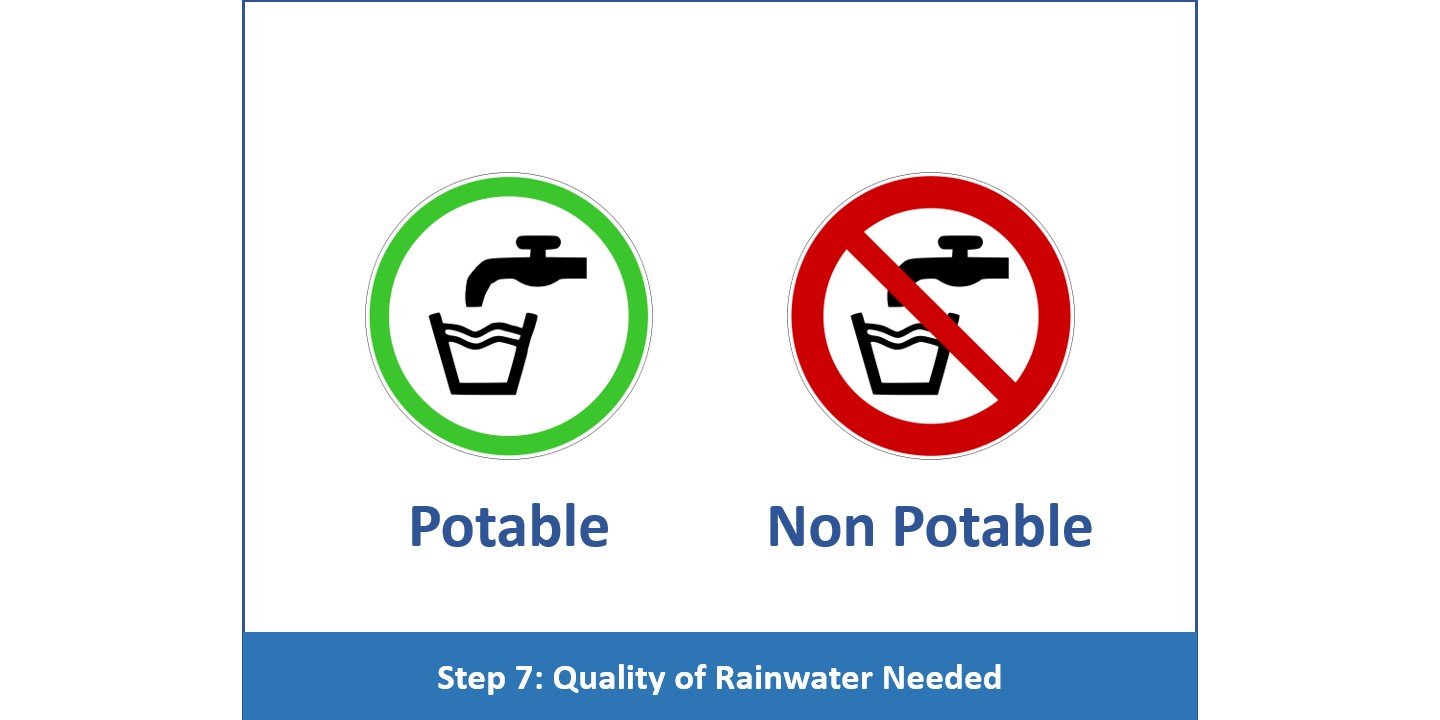
Whether additional equipment will be needed (Step 8), will depend on the answers and plan specifics of the other steps. Additional equipment common to rainwater harvesting include a water pump, filtration unit, and treatment system.
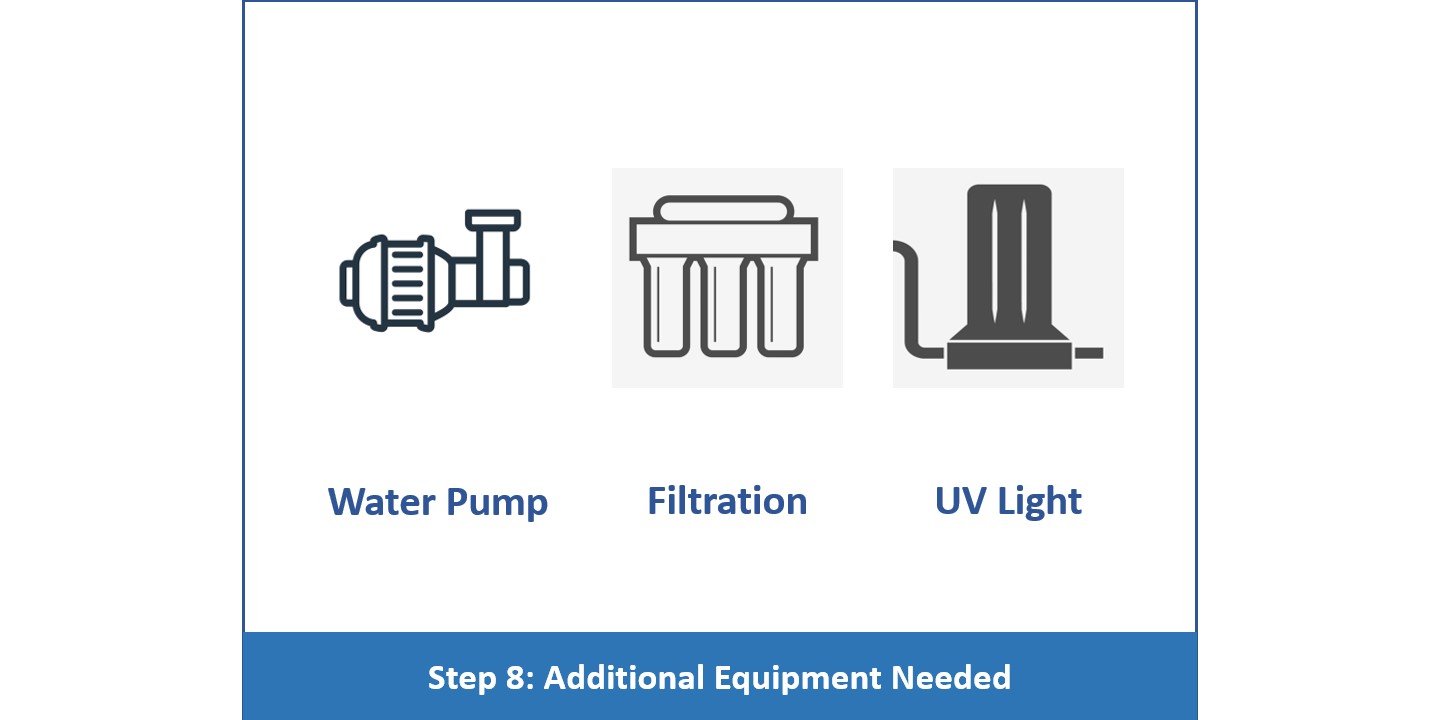
How to Set Up a Rainwater System
When a good overview and plan for your rainwater harvesting system is in place, you should know or have an idea of (1) how much water you will collect, (2) the size of the collection container or containers, and (3) what additional equipment you will need.
From here, prepare the location for the rain tank(s) or have it prepared by a contractor, install a leaf eater and first flush diverter in the downspout area of the conveyance system, run the conveyance system so it deposits rainwater into the collection tank, then set up the plumbing connections to the rain tank so you can withdraw and clean your harvested rainwater as needed.
Additional Recommendations and Points
When large volumes of rainwater are to be collected and used for livestock operations, the use of multiple tanks is recommended. Multiple rain tanks can be used to increase the total amount of rainwater that can be collected, make the tank and system easier to install, reduce the amount of land space needed in one location, allow the rain tank and harvest system to be located closer to the point of capture and use, and provide system security – if something goes wrong with one tank, other tanks on the property can serve as a backup.
Special rebates and incentive programs may be available for your state or regional area depending on your operation and intended rainwater collection system. They can range from tax rebates, property tax reductions, to program loans and fund accounts.
A good example of a state-supported funding program is the State of Kentucky On Farm Water Management Program that provides special funding to promote water sourcing innovation on farms including rainwater harvesting.
Checking with your local state department is the best route for determining rainwater incentives in your area. The correct state department can vary based on where you live.
Takeaway | Using a Rainwater Harvesting System for Livestock

Using a rainwater harvesting system for livestock can serve as a supplemental or alternative water source to supply the water needed in livestock raising operations. Many livestock ranches and farms are ideal for harvesting and using rainwater as many properties already feature structures with large roofs capable of catching large volumes of water that can easily be put to good use by implementing a rainwater system.
If looking for the equipment to setup your own rainwater harvesting system, we offer the following products:
Should you have further questions or need assistance in selecting the equipment for your rainwater harvesting system, contact our professional support staff.